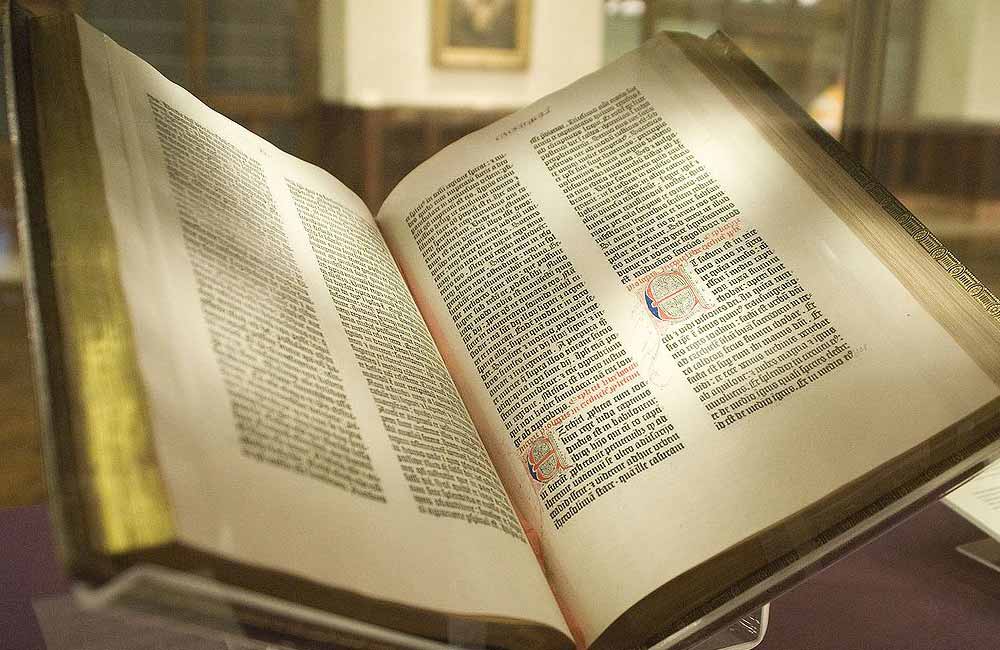- Mon - Fri
- 9:00 am - 05:00 pm EST
- Closed on Weekends

Dateline: March 10, 1986 – A story appears in Time Magazine about how a refurbished cyclotron on the Davis campus of the University of California had been used to analyze the elements in the inks of a) the Gutenberg Bible, b) Bach’s Bible, c) the Vinland map, and d) the Dead Sea Scrolls, all of which were sent to Davis to be analyzed. In each case, the analysis permitted significantv conclusions to be drawn: a) Gutenberg practiced by printing the 36-line Bible and the Sibyllenbuch fragment, b) it was Bach himself who did all that underlining in the Bible, and not a subsequent owner, c) the Vinland map is real, and d) the Dead Sea Scrolls had been preserved by being soaked in salt water. In the case of the Vinland map, which had been called a fraud because some particles of ink from the map had been shown to be titanium-based, was made with carbon ink, with only a trace of titanium. These tests are supposedly more reliable than previous ones because the data is gotten from the X-rays emitted by a beam of protons that penetrates the object and is not merely reflected. The article stated that the historian and physicist who carried these tests out “can determine in remarkable detail the chemical composition of both ink and paper, without damaging either.”v
The element titanium has been identified in a number of inks from historical documents. However, no analyses of these inks had been carried out in order to determine in what molecular form the titanium was present. There was a need for further studies of historical inks. Information was needed about their preparation, which previously had been thought to contain the compound anatase, a component of medieval inks. The reported presence of anatase in the Vinland Map ink had been forwarded as evidence of the modern manufacture of the map. Other elements, such as copper, zinc, and aluminum, that are present in the Vinland Map ink, are shown to be consistent with the medieval method of preparation of green vitriol, a known component of inks, which strongly suggested that the Map’s ink is in fact medieval.
During regular beam times taking place about every 4 weeks at ELSA different tests of the general performance of the method were completed. As first applications the following projects were started: Non-destructive analysis on papers and inks of early printings
After the first pioneering PIXE results of the Davies group in California the analysis of inks as a new tool for the research of the history of early printing is under investigation. It is hoped that each printer or each printing-office can be recognized by his or its recipe of ink manufacturing. Using the better suited SYXRF method (energy deposited for our set-up about 1/66 of full sun light) about 20 different printings of the 15th century have been analysed until now. In Fig. 1 X-ray spectra from ink & paper and paper only of a leaf of the famous B-42 bible from Gutenberg are shown and in Tab. 1 the absolute analytical results are presented. The large scatter is due to varying ink thicknesses. Only Ni, Cu and Pb are found to be significant elements of the ink, all the other elements analysed are in the paper. The thickness of the ink layer of the odd page is 3 times higher than the even page, but the elemental ratios are the same (Cu/Pb = 1.0, Ni/Pb = 7.10-3). Gutenberg inks have unusually high Cu and Pb content compared to the other printings analysed. (in collaboration with with M. Boghardt, H. Halbey and E.-M. Hanebutt-Benz)

Family owned and operated since 1979 (formerly known as EAC), we strive to give each customer the best service possible.
From Aerospace to Pharmaceuticals, we will work with you to tailor your specific analytical method.
Please call us at 859-254-5115 or email Info@ElementalAnalysis.com if you have any questions.
Please call us at 859-254-5115 or email Info@ElementalAnalysis.com if you have any questions.
Please call us at 859-254-5115 or email Info@ElementalAnalysis.com if you have any questions.